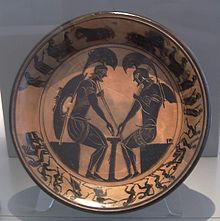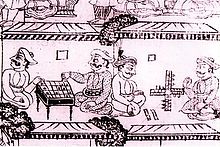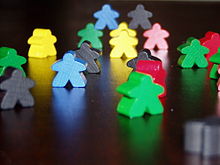
Board game
Background to the schools Wikipedia
The articles in this Schools selection have been arranged by curriculum topic thanks to SOS Children volunteers. SOS mothers each look after a a family of sponsored children.
A board game is a game that involves counters or pieces moved or placed on a pre-marked surface or "board", according to a set of rules. Games can be based on pure strategy, chance (e.g. rolling dice) or a mixture of the two, and usually have a goal that a player aims to achieve. Early board games represented a battle between two armies, and most current board games are still based on defeating opposing players in terms of counters, winning position or accrual of points (often expressed as in-game currency).
There are many different types and styles of board games. Their representation of real-life situations can range from having no inherent theme, as with checkers, to having a specific theme and narrative, as with Cluedo. Rules can range from the very simple, as in Tic-tac-toe, to those describing a game universe in great detail, as in Dungeons & Dragons (although most of the latter are role-playing games where the board is secondary to the game, helping to visualize the game scenario).
The amount of time required to learn to play or master a game varies greatly from game to game. Learning time does not necessarily correlate with the number or complexity of rules; some games, such as chess or Go, have simple rulesets while possessing profound strategies.
History

Board games have been played in most cultures and societies throughout history; some even pre-date literacy skill development in the earliest civilizations. A number of important historical sites, artifacts, and documents shed light on early board games. These include:
- Jiroft civilization gameboards
- Senet has been found in Predynastic and First Dynasty burials of Egypt, c. 3500 BC and 3100 BC respectively. Senet is the oldest board game known to have existed, and was pictured in a fresco found in Merknera's tomb ( 3300– 2700 BC).
- Mehen, another ancient board game from Predynastic Egypt
- Go, an ancient strategic board game originating in China
- Patolli, a board game originating in Mesoamerica played by the ancient Aztec
- Royal Game of Ur, the Royal Tombs of Ur contain this game, among others
- Buddha games list, the earliest known list of games
- Pachisi and Chaupar, ancient board games of India
Timeline
- c. 3500 BC: Senet is played in Predynastic Egypt as evidenced by its inclusion in burial sites; also depicted in the tomb of Merknera.
- c. 3000 BC: The Mehen board game from Predynastic Egypt, played with lion-shaped game pieces and marbles.
- c. 3000 BC: Ancient backgammon set, found in the Burnt City in Iran.
- c. 2560 BC: Board of the Royal Game of Ur (found at Ur Tombs)
- c. 2500 BC: Paintings of Senet and Han being played depicted in the tomb of Rashepes
- c. 1500 BC: Painting of board game at Knossos.
- c. 500 BC: The Buddha games list mentions board games played on 8 or 10 rows.
| a | b | c | d | e | f | g | h | ||
| 8 | 8 | ||||||||
| 7 | 7 | ||||||||
| 6 | 6 | ||||||||
| 5 | 5 | ||||||||
| 4 | 4 | ||||||||
| 3 | 3 | ||||||||
| 2 | 2 | ||||||||
| 1 | 1 | ||||||||
| a | b | c | d | e | f | g | h |
- c. 500 BC: The earliest reference to Pachisi in the Mahabharata, the Indian epic.
- c. 400 BC: Two ornately decorated liubo gameboards from a royal tomb of the State of Zhongshan in China.
- c. 400 BC: The earliest written reference to Go (weiqi) in the historical annal Zuo Zhuan. Go is also mentioned in the Analects of Confucius (c. 5th century BC).
- 116–27 BC: Marcus Terentius Varro's Lingua Latina X (II, par. 20) contains earliest known reference to Latrunculi (often confused with Ludus Duodecim Scriptorum, Ovid's game mentioned below).
- 1 BC – 8 AD: Ovid's Ars Amatoria contains earliest known reference to Ludus Duodecim Scriptorum.
- 1 BC – 8 AD: The Roman Game of kings is a game of which little is known, and is more or less contemporary with the Latrunculi.
- c. 43 AD: The Stanway Game is buried with the Druid of Colchester.
- c. 200 AD: A stone Go board with a 17×17 grid from a tomb at Wangdu County in Hebei, China.
- 220–265: Backgammon enters China under the name t'shu-p'u (Source: Hun Tsun Sii)
- c. 400 onwards: Tafl games played in Northern Europe.
| a | b | c | d | e | f | g | h | ||
| 8 | 8 | ||||||||
| 7 | 7 | ||||||||
| 6 | |
|
|
|
|
|
|
|
6 |
| 5 | |
|
|
|
|
|
|
|
5 |
| 4 | |
|
|
|
|
|
|
|
4 |
| 3 | |
|
|
|
|
|
|
|
3 |
| 2 | 2 | ||||||||
| 1 | 1 | ||||||||
| a | b | c | d | e | f | g | h |
- c. 600: The earliest references to chaturanga written in Subandhu's Vasavadatta and Banabhatta's Harsha Charitha early Indian books.
- c. 600: The earliest reference to shatranj written in Karnamak-i-Artakhshatr-i-Papakan.
- c. 700: Date of the oldest evidence of Mancala games, found in Matara, Eritrea and Yeha.
- c. 1283: Alfonso X of Castile in Spain commissioned Libro de ajedrez, dados, y tablas ( Libro de los Juegos (The Book of Games)) translated into Castilian from Arabic and added illustrations with the goal of perfecting the work.
- 1759: A Journey Through Europe published by John Jefferys, the earliest board game with a designer whose name is known.
- 1874: Parcheesi is trademarked by Selchow & Righter.
- c. 1930: Monopoly stabilises into the version that is currently popular.
- 1938: The first version of Scrabble published by Alfred Butts under the name "Criss-Crosswords".
- 1957: Risk is released.
- 1970: The code-breaking board game Mastermind is designed by Mordecai Meirowitz.
- c. 1980: German-style board games begin to develop as a genre.
Many board games are now available as video games, which can include the computer itself as one of several players, or as a sole opponent. The rise of computer use is one of the reasons said to have led to a relative decline in board games. Many board games can now be played online against a computer and/or other players. Some websites allow play in real time and immediately show the opponents' moves, while others use email to notify the players after each move (see the links at the end of this article). Modern technology (the internet and cheaper home printing) has also influenced board games via the phenomenon of print-and-play board games that you buy and print yourself.
Some board games make use of components in addition to—or instead of—a board and playing pieces. Some games use CDs, video cassettes, and, more recently, DVDs in accompaniment to the game.
Psychology
While there has been a fair amount of scientific research on the psychology of older board games (e.g., chess, Go, mancala), less has been done on contemporary board games such as Monopoly, Scrabble, and Risk. Much research has been carried out on chess, in part because many tournament players are publicly ranked in national and international lists, which makes it possible to compare their levels of expertise. The works of Adriaan de Groot, William Chase, Herbert A. Simon, and Fernand Gobet have established that knowledge, more than the ability to anticipate moves, plays an essential role in chess-playing. This seems to be the case in other traditional games such as Go and Oware (a type of mancala game), but data is lacking in regard to contemporary board games.
Additionally, board games can be therapeutic. Bruce Halpenny, a games inventor said when interviewed about his game, “With crime you deal with every basic human emotion and also have enough elements to combine action with melodrama. The player’s imagination is fired as they plan to rob the train. Because of the gamble they take in the early stage of the game there is a build up of tension, which is immediately released once the train is robbed. Release of tension is therapeutic and useful in our society, because most jobs are boring and repetitive.”
Linearly arranged board games have been shown to improve children's spatial numerical understanding. This is because the game is similar to a number line in that they promote a linear understanding of numbers rather than the innate logarithmic one.
Common terms
Although many board games have a jargon all their own, there is a generalized terminology to describe concepts applicable to basic game mechanics and attributes common to nearly all board games.
- Gameboard (or simply board)—the (usually quadrilateral) surface on which one plays a board game. The namesake of the board game, gameboards would seem to be a necessary and sufficient condition of the genre, though card games that do not use a standard deck of cards (as well as games that use neither cards nor a gameboard) are often colloquially included. Most games use a standardized and unchanging board (chess, Go, and backgammon each have such a board), but many games use a modular board whose component tiles or cards can assume varying layouts from one session to another, or even while the game is played.
- Game piece (or gamepiece, counter, token, bit, meeple, mover, pawn, man, playing piece, player piece)—a player's representative on the gameboard made of a piece of material made to look like a known object (such as a scale model of a person, animal, or inanimate object) or otherwise general symbol. Each player may control one or more game pieces. Some games involve commanding multiple game pieces (or units), such as chess pieces or Monopoly houses and hotels, that have unique designations and capabilities within the parameters of the game; in other games, such as Go, all pieces controlled by a player have the same capabilities. In some modern board games, such as Clue, there are other pieces that are not a player's representative (i.e. weapons). In some games, pieces may not represent or belong to any particular player. See also: Counter (board wargames)
- Jump (or leap)—to bypass one or more game pieces or spaces. Depending on the context, jumping may also involve capturing or conquering an opponent's game piece. (See also: Game mechanic: capture)
- Space (or square)—a physical unit of progress on a gameboard delimited by a distinct border. Alternatively, a unique position on the board on which a game piece may be located while in play. (In Go, for example, the pieces are placed on intersections of lines on the grid, not in the areas bounded by borders, as in chess.) (See also: Game mechanic: Movement)
- Hex (or cell)—in hexagon-based board games, this is the common term for a standard space on the board. This is most often used in wargaming, though many abstract strategy games such as Abalone, Agon, hexagonal chess, and connection games use hexagonal layouts.
- Card—a piece of cardboard often bearing instructions, and usually chosen randomly from a deck by shuffling.
- Deck—a stack of cards.
- Capture—a method that removes another player's game piece(s) from the board. For example: in checkers, if a player jumps the opponent's piece, that piece is captured.









